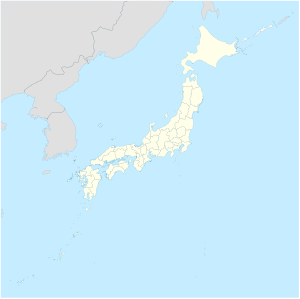Nishinoshima (Tokyo)
| Nishinoshima | ||
|---|---|---|
| Aerial photo of Nishinoshima and "Niijima" from December 24, 2013 | ||
| Waters | Pacific Ocean | |
| Geographical location | 27 ° 14 '49 " N , 140 ° 52' 28" E | |
|
|
||
| surface | 3.7 km² | |
| Highest elevation | 100 m | |
| Residents | uninhabited | |
Nishinoshima ( Japanese 西 之 島 , literally: "western island", English Rosario Island ) is a small volcanic island in the Pacific Ocean . It belongs to the Japanese Ogasawara Islands and therefore administratively to Tokyo Prefecture . The island is occasionally counted as part of the Bonin Islands chain . However, this is incorrect from a geographical and geological point of view. Although the island is closest to Chichi-jima in the central Bonin Islands, it is not only separated from them by a distance of over 130 km, but also by the Ogasawara trough , which is more than 4000 meters deep .
The uninhabited island is located about 950 km south of Honshū on the ridge of the sea on which the Izu Islands further north and the Kazan-rettō ( volcanic islands ) further south and which later continues in the arch of the Mariana Islands . It is about 150 km away from Chichi-jima , on the eastern ridge of the Ogasawara Islands.
Nishinoshima is the 29 hectare tip of an underwater volcano , which protrudes up to 38 m from the sea . In 1973 and 1974, several eruptions occurred that completely redesigned the island and created three other small rock islands, which meanwhile come with it the main island have merged.
Eruptions and growth 2013–2015
On November 21, 2013, a submarine eruption formed another island about 200 meters south-southeast of Nishinoshima, 300 by 200 meters in size. The island continued to enlarge due to eruptions and reached an area of 5.6 hectares and a height of 25 m in early December. By December 26, 2013, the initially elongated island took on a more rounded shape and now had dimensions of 450 meters by 500 meters. She already touched the neighboring island of Nishinoshima in two places and was about to merge with it. On April 7, 2014, it was reported that the islands were now united into a single land mass. The island has no official name, but is simply called "new island" ( 新 島 ) in Japanese reports , which reads shintō or alternatively Niijima .
By growing together, this "new island" lost its independence and thus its identity as an island, the land mass, which had grown together from two islands to form one island, stretched over 1,550 meters from east to west and 1,350 meters from north to south, like the coast guard via transmitter NHK reported on July 23, 2014. On December 27, 2014, Japanese authorities announced that the island had reached a size of 2.3 km² and protruded 110 m from the sea. From an article dated November 22, 2015 it can be learned that the island had now reached a size of 1.9 km × 1.95 km (3.7 km²) at a height of 100 m.
gallery
First human visit
In October 2016 , geologists and biologists from the Japanese Ministry of the Environment entered the island for the first time. They installed seismic sensors and conducted animal and plant colonization studies. The masked booby ( Sula dactylatra ) is the first large creature to permanently colonize the island. Several species of dolphins , short-finned pilot whales , and humpback whales were seen prior to the eruption, and some of them have been confirmed to be returning.
Web links
- Nishinoshima in the Global Volcanism Program of the Smithsonian Institution (English)
- Nishinoshima in the Japanese Volcanoes Quaternary database (English and Japanese)
- Nishinoshima in hydrographic and oceanographic department of the Japan Coast Guard (English)
- Nishinoshima at the Geospatial Information Authority of Japan (GSI; Japanese)
- Nishinoshima at the Japan Meteorological Agency (Japanese)
Individual evidence
- ↑ Elaine Kurtenbach: Volcano Raises New Island Far South of Japan. In: Time.com. November 21, 2013, archived from the original on December 3, 2013 ; accessed on July 29, 2016 .
- ↑ Axel Bojanowski : Pacific: Japan's new island defies the floods. In: Spiegel Online. December 22, 2013, accessed December 22, 2013 .
- ↑ Terra Nova (Spanish) at www.montevideo.com.uy of December 26, 2013, accessed December 26, 2013
- ↑ Japan: Island unites with neighboring island in the Pacific. In: Spiegel Online. April 7, 2014, accessed April 7, 2014 .
- ↑ Brian Clark Howard: 小 笠原 諸島 、 西 之 島 沖 に “新 島” . In: National Geographic. November 22, 2013, archived from the original on November 22, 2014 ; Retrieved July 29, 2016 (Japanese).
- ↑ http://orf.at/#/stories/2239307/ Newly discovered Japanese island continues to grow, ORF.at from July 25, 2014
- ↑ http://www.bbc.com/news/world-asia-30610447
- ↑ http://volcano.si.edu/volcano.cfm?vn=284096
- ↑ Nishinoshima. In: MLIT . Retrieved July 29, 2016 (Japanese).
- ↑ Axel Bojanowski: Researcher on Nishinoshima: First people set foot on new island. In: Spiegel Online . October 31, 2016, accessed June 10, 2018 .
- ↑ Hidaka T. Kasuya T. Izawa K. Kawamichi T. 1996. The encyclopaedia of animals in Japan (2) - Mammals 2. ISBN 9784582545524 Heibonsha
- ^ Ogasawara Whale Watching Association. 2017. The last 硫黄 三島 & 西 之 島 cruise of the second Ogasawaramaru , "Megaptera" the organa bulletin. Vol. 73 and 74. ISSN 1343-3091
- ↑ 西 之 島 新 島 と ク ジ ラ Nishinoshima New Island and whales on Youtube




